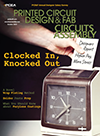Products
Aquanox A4520T Aqueous Chemistry for flush mounted and fine-pitch components is designed to clean under low standoffs and in the tight spaces caused by smaller, more heavily populated devices. Said to be effective on all lead-free, no-clean and eutectic materials available today, while providing the low cost of ownership.
Works at low temperatures and low concentrations while exceeding industry standards for people and environmental safety. Easy to use, effective without sump side additives. Also features a long bath life, is RoHS compliant.
Can clean numerous soils including lead-free flux, tacky flux, reflowed paste, no-clean flux, RMA flux, OA paste, oils, fingerprints, light oxides and polymerized soils. Is multi-metal safe for use on yellow metals, aluminum, ferrous and composites in addition to most precious metals. The biodegradable aqueous solution is non-flammable and non-corrosive.
Available commercially in one, five and 55 gallon containers.
Kyzen Corp., kyzen.com
Works at low temperatures and low concentrations while exceeding industry standards for people and environmental safety. Easy to use, effective without sump side additives. Also features a long bath life, is RoHS compliant.
Can clean numerous soils including lead-free flux, tacky flux, reflowed paste, no-clean flux, RMA flux, OA paste, oils, fingerprints, light oxides and polymerized soils. Is multi-metal safe for use on yellow metals, aluminum, ferrous and composites in addition to most precious metals. The biodegradable aqueous solution is non-flammable and non-corrosive.
Available commercially in one, five and 55 gallon containers.
Kyzen Corp., kyzen.com
Booth 1401
For the past year, RVSI Inspection has offered customers the opportunity to replace the core inspection module of their MicroMap 3-D based LS series tools. The company will now expand the program.
In the past, these upgrades were done at the RVSI factory by exchanging a series of parts. Under the new plan, RVSI Inspection ships a fully functioning/fully tested inspection cabinet to the customer site, where it is exchanged with the older cabinet, taking full advantage of the handler that is already part of the system. This “replacement” can occur at less than half the price of a new tool yet performs at 2X the speed on average. This replacement concept reduces shipping time.
The program is offered on LS-3950, LS-7100 and LS-7700 model RVSI Lead Scanner systems.
RVSI Inspection, rvsi.com
In the past, these upgrades were done at the RVSI factory by exchanging a series of parts. Under the new plan, RVSI Inspection ships a fully functioning/fully tested inspection cabinet to the customer site, where it is exchanged with the older cabinet, taking full advantage of the handler that is already part of the system. This “replacement” can occur at less than half the price of a new tool yet performs at 2X the speed on average. This replacement concept reduces shipping time.
The program is offered on LS-3950, LS-7100 and LS-7700 model RVSI Lead Scanner systems.
RVSI Inspection, rvsi.com
NuSil Technology, a manufacturer of silicone-based materials for military, aerospace, electronics and photonics, has expanded its line of electronic packaging materials (EPMs).
All materials in this line will have low outgassing properties to prevent contamination. They have undergone extensive processing and maintain weight losses of less than 1% after exposure to temperatures exceeding 275°C for one hour. Other materials used in this industry are said to exhibit weight losses four to five times that of the NuSil materials.
Among the new offerings are potting and encapsulating materials; static-dissipative and glop top materials; dielectric gels; and thermal interface materials (TIMs), which come in grease, adhesive and gel forms.
All materials in this line will have low outgassing properties to prevent contamination. They have undergone extensive processing and maintain weight losses of less than 1% after exposure to temperatures exceeding 275°C for one hour. Other materials used in this industry are said to exhibit weight losses four to five times that of the NuSil materials.
Among the new offerings are potting and encapsulating materials; static-dissipative and glop top materials; dielectric gels; and thermal interface materials (TIMs), which come in grease, adhesive and gel forms.
NuSil Technology, www.nusil.com
Press Releases
- StenTech Strengthens Precision Parts Platform with AME Acquisition
- Count On Tools Enhances Selective Soldering Precision with Expanded Nozzle Lineup
- ViTrox Presents Advanced Inspection and Smart Manufacturing Solutions at NEPCON Asia 2025
- ASC Sunstone Circuits Adds New Options to OneQuote While Maintaining Real-Time Pricing on Core PCB Features


